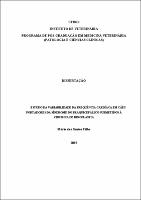| ???jsp.display-item.social.title??? |


|
Please use this identifier to cite or link to this item:
https://tede.ufrrj.br/jspui/handle/jspui/5143| ???metadata.dc.type???: | Dissertação |
| Title: | Estudo da variabilidade da frequência cardíaca em cães portadores da síndrome do braquicefálico submetidos à cirurgia de rinoplastia. |
| Other Titles: | Study of heart rate variability in dogs with brachycephalic syndrome submitted to rhinoplasty surgery. |
| ???metadata.dc.creator???: | Santos Filho, Mário dos  |
| ???metadata.dc.contributor.advisor1???: | Fernandes, Julio Israel |
| ???metadata.dc.contributor.advisor2???: | Paiva, Jonimar Pereira |
| ???metadata.dc.contributor.referee1???: | Fernandes, Julio Israel |
| ???metadata.dc.contributor.referee2???: | Bendas, Alexandre José Rodrigues |
| ???metadata.dc.contributor.referee3???: | Veiga, Cristiano Chaves Pessoa da |
| ???metadata.dc.description.resumo???: | As raças braquicefálicas apresentam índice de tônus vasovagal maior que cães não braquicefálicos. O processo obstrutivo de vias aéreas superiores prejudica o trabalho inspiratório reduzindo a inibição parassimpática normal desta fase do ciclo respiratório. O presente estudo teve por objetivo avaliar a VFC (Variabilidade da frequência cardíaca) nas raças braquicefálicas, antes e após a correção cirúrgica da estenose de narinas, por meio de eletrocardiografia prolongada, observando o excesso da estimulação parassimpática no que tange a ocorrência de bradiarritmias e suas consequências clinicas, e a possibilidade de melhora do balanceamento autonômico após o tratamento, aumentando a qualidade e expectativa de vida destes pacientes. Foram incluídos 16 cães com estenose de narinas, onde realizou-se o estudo analítico e progressivo da evolução dos achados da VFC em diferentes momentos, antes do proedimento cirúrgico (dia 0) e após o procedimento em dois momentos, 30 e 60 dias. A correção cirúrgica procedeu-se por meio da técnica de alavestibulplastia e a análise da VFC foi registrada por meio da eletrocardiografia prolongada. Para este exame foi realizada análise dos índices no domínio no tempo. Quanto aos achados clínicos houve melhora na avaliação da freqüência cardíaca e respiratória média após a cirurgia de rionoplastia, bem como redução da atividade parassimpática sob o Sistema Nervoso Autônomo (SNA), no que diz as repeito as bradiarritmias em todos os pacientes. Quanto aos índices de VFC no domínio do tempo, rMSSD (Root-Mean of square sucessive NN interval difference) e SDNN (Standard Deviation of all normal NN interval) associados aos achados da frequência cardíaca média, comparados nos momentos distintos, trouxeram fortes indícios que a redução da estimulação parassimpática está relacionada a redução da VFC nesses animais. Os achados relacionados a redução das bradiarritmias corroboram para a análise interpretativa dos índices do gráfico de Lorenz, onde ocorre redução do índice cardiovagal, sem alteração significativa dos índices cardiosimpáticos ao longo do estudo. O rMSSD é o índice de VFC no domínio do tempo que precocemente alterado pode ser utilizado como indicador do aumento da atividade parassimpática causada pela Síndrome Braquicefálica (SB). |
| Abstract: | The brachycephalic breeds have a higher vasovagal tonus index than non-brachycephalic dogs. The obstructive upper airway process impairs inspiratory work by reducing the normal parasympathetic inhibition of this phase of the respiratory cycle. The aim of the present study was to evaluate the HRV in the brachycephalic races, before and after surgical correction of the stenosis of the nostrils, by means of prolonged electrocardiography, observing the excess of the parasympathetic stimulation in relation to the occurrence of bradyarrhythmias and its clinical consequences, and the possibility of improving autonomic balancing after treatment, increasing the quality and life expectancy of these patients. Sixteen dogs with nostril stenosis were included, where the analysis and progression of the HRC findings at different moments before the surgical procedure (day 0) and after the procedure were performed in two moments, 30 and 60 days. Surgical correction was performed by means of the alavestibulplasty technique and HRV analysis was recorded by means of prolonged electrocardiography. For this examination, the indexes were analyzed in the time domain. Regarding the clinical findings, there was an improvement in the evaluation of the heart and respiratory rate after the rhinoplasty surgery, as well as a reduction of the parasympathetic activity under the Autonomic Nervous System (ANS), in which the bradyarrhythmias in all patients are repeated. Regarding HRV indexes in the time domain, rMSSD (Root-Mean of square sucessive NN interval difference) and SDNN (Standard Deviation of all normal NN interval) associated with mean heart rate findings, compared at different times, have provided strong evidence that the reduction of parasympathetic stimulation is related to the reduction of HRV in these animals. The findings related to the reduction of bradyarrhythmias corroborate the interpretive analysis of the indices of the Lorenz chart, where there is a reduction of the cardiovagal index, without a significant change in the cardiosympathetic indexes throughout the study. The rMSSD is the HRV index in the time domain that can be used as an indicator of the increase in parasympathetic activity caused by Brachycephalic Syndrome (BS). |
| Keywords: | doença das vias aéreas síndrome do braquicefálico balanço autonômico airways disease brachycephalic syndrome autonomic balance |
| ???metadata.dc.subject.cnpq???: | Medicina Veterinária |
| Language: | por |
| ???metadata.dc.publisher.country???: | Brasil |
| Publisher: | Universidade Federal Rural do Rio de Janeiro |
| ???metadata.dc.publisher.initials???: | UFRRJ |
| ???metadata.dc.publisher.department???: | Instituto de Veterinária |
| ???metadata.dc.publisher.program???: | Programa de Pós-Graduação em Medicina Veterinária (Patologia e Ciências Clínicas) |
| Citation: | SANTOS FILHO, Mário dos. Estudo da variabilidade da frequência cardíaca em cães portadores da síndrome do braquicefálico submetidos à cirurgia de rinoplastia. 2019. 70 f. Dissertação (Mestrado em Medicina Veterinária, Patologia e Ciências Clínicas). Instituto de Veterinária, Universidade Federal Rural do Rio de Janeiro, Seropédica, RJ, 2019. |
| ???metadata.dc.rights???: | Acesso Aberto |
| URI: | https://tede.ufrrj.br/jspui/handle/jspui/5143 |
| Issue Date: | 26-Feb-2019 |
| Appears in Collections: | Mestrado em Medicina Veterinária (Patologia e Ciências Clínicas) |
Files in This Item:
| File | Description | Size | Format | |
|---|---|---|---|---|
| 2019 - Mário dos Santos Filho.pdf | 2019 - Mário dos Santos Filho | 10.18 MB | Adobe PDF |  Download/Open Preview |
Items in DSpace are protected by copyright, with all rights reserved, unless otherwise indicated.




